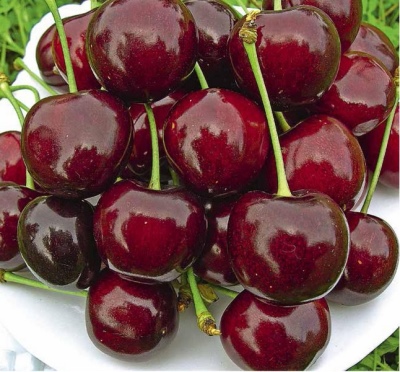
- Fruit shape: flat-rounded, with a well-defined abdominal suture line
- Peduncle: 35-40 mm, firmly attached
- Authors: France
- Name synonyms: Bigarrean Hatif Burlat, Bigarro Ativ Burlat, Bigarro early Burlat, Bigarrean Burlat, Еаrly Вurlat
- Growth type: medium-sized
- Appointment: for all types of processing, for fresh consumption
- Yield: good
- Crown: round, thick
- Escapes: slightly curved, light brown
- Sheet: oval
The explanation that sweet cherry is one of the most favorite crops for growing among gardeners is the simplest. Early fruiting allows you to get fresh fruit on your own plot already at the beginning of summer, and in addition, the tree has a very attractive appearance during and after flowering.
The Bigarro Burlat variety (synonyms - Bigarrean Hatif Burlat, Bigarro Ativ Burlat, Bigarro early Burlat, Bigarrean Burlat, Еаrly Вurlat) is one of the brightest representatives of this category. The berry has excellent marketability and good transportability. The fruits are used fresh, for conservation, freezing and in the preparation of confectionery.
Description of the variety
A medium-sized plant with a rounded, almost spherical crown, has shoots of light brown tones and lighter branches, often covered with lenticels. The average life span of a plant is up to 17 years or more. The crown is covered with elongated, oval-pointed, elliptical light green foliage with a matte surface.
Cherry blooms with large (up to 3 cm in diameter), snow-white fragrant flowers, remaining solitary or collected in three-flowered inflorescences. Unfortunately, female-type flowers are formed on the tree, which forces the planting of pollinating varieties.
Fruit characteristics
Large (6.4 g) flat-round fruits have a pronounced abdominal suture. The color is intense dark red, during the period of physiological ripeness, it turns into tones close to black. A large (0.4 g) stone separates well from the pulp, the skin is resistant to cracking, except for oversaturation with moisture.
Taste qualities
Dark red pulp of medium density has a balanced sweet taste with a subtle hint of sourness. The composition contains: dry substances (14.7%), sugars (11.2%), titratable acids (0.6%), ascorbic acid (6 mg / 100 g).
Ripening and fruiting
Regular fruiting occurs at 4–5 years. The variety belongs to the early fruiting category - the harvest begins in the first decade of June.

Yield
The variety is characterized as medium-yielding; an average of 80 kg of tasty and healthy berries are harvested from one tree.
Self-fertility and the need for pollinators
The most suitable varieties for pollination are Ge-Delfingen, Bigarro Starking, Napoleon, Exhibition.
Growing and care
For planting, sunny areas are chosen, well protected from northern winds and constant drafts. Slopes with a southern exposure are suitable, as protection - walls of buildings or high fences. The ideal soil for optimal plant development is a fertile, breathable, well-drained soil with a neutral acidity level. The proximity of groundwater or swampy lowlands is unacceptable.Acidic soils are deoxidized with dolomite flour; if necessary, artificial embankments are made for planting seedlings above ground level.
The optimal timing for planting: autumn, if we are talking about the southern regions, and spring, if planting is carried out in colder areas. Simultaneously with Bigarro Burlat, pollinating varieties are planted. The distance between the roots is 3 m, in the aisles - up to 5 m. When choosing planting material, you need to ensure that different varieties are of the same age, preference should be given to 2-3 year old seedlings with a well-developed root system and the presence of buds.
The depth and dimensions of the pit are 60x60x80 cm. The bottom is covered with a 10-15 cm layer of drainage from pebbles and gravel. At the same time, a support for fragile stems is installed. The excavated layer of fertile soil is enriched with humus, superphosphate, complex mineral fertilizers, and wood ash. After planting, the trunk circle is watered abundantly with warm water.
Further care consists in observing traditional agricultural practices.
- Watering. Young plants are watered as needed. Mature trees need irrigation in May and late autumn.
- Weeding and loosening will help the young plant adapt and grow stronger faster.
- Top dressing. Beginning from the second year after planting:
- early spring - nitrogen;
- late autumn - the introduction of humus into the trunk circle along with superphosphate and potassium sulfate.
- Sanitary pruning is done in early spring. At this time, dry, damaged shoots are removed.
- Formative pruning begins immediately after planting, when the plant is shortened to 50–70 cm. Then, make sure that the guide is above the skeletal branches. As a result, several tiers are formed.
In spring and autumn, the trunks and part of the lower branches must be whitened to protect the tree from pests and rodents.




Disease and pest resistance
The variety is considered relatively resistant to diseases, so preventive fungicide treatments will be useful.

Requirements for soil and climatic conditions
Bigarro Burlat has an average winter hardiness, which makes it impossible to grow it in areas of risky farming. However, we must give him his due, he tolerates return frosts well.
































































